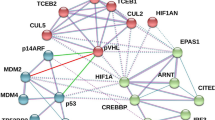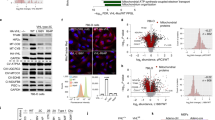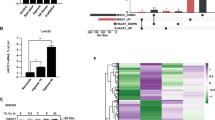Abstract
The von Hippel-Lindau (VHL) tumour suppressor gene encodes a substrate-specifying component of an E3 ubiquitin ligase that targets hypoxia-inducible factor (HIF) α subunits for degradation under normoxia. The VHL protein is composed of an N-terminal HIFα-binding β domain and a C-terminal α domain, which is necessary and sufficient for the formation of the E3 multiprotein enzyme. A large number of disease-causing mutations in either the α or β domain renders HIFα stable irrespective of oxygen tension, leading to the upregulation of numerous HIF-target genes, such as GLUT1 and VEGF. Here, we show that VHL forms a self-associated complex in vivo, but not in vitro, and demonstrate that coexpression of two different VHL missense mutants — one in the α domain and the other in the β domain — restores HIF-mediated gene expression profile. These findings indicate that VHL homotypic complexes can function in vivo in a complementary fashion to target HIFα for ubiquitin-mediated proteolysis, and potentially explain why VHL-associated tumours with a missense mutation-carrying VHL allele is almost invariably accompanied by a second VHL allele harbouring a gross truncation or deletion.
This is a preview of subscription content, access via your institution
Access options
Subscribe to this journal
Receive 50 print issues and online access
$259.00 per year
only $5.18 per issue
Buy this article
- Purchase on Springer Link
- Instant access to full article PDF
Prices may be subject to local taxes which are calculated during checkout




Similar content being viewed by others
References
Ang SO, Chen H, Hirota K, Gordeuk VR, Jelinek J, Guan Y et al. (2002). Nat Genet 32: 614–621.
Bradley JF, Collins DL, Schimke RN, Parrott HN, Rothberg PG . (1999). Am J Med Genet 87: 163–167.
Clifford SC, Cockman ME, Smallwood AC, Mole DR, Woodward ER, Maxwell PH et al. (2001). Hum Mol Genet 10: 1029–1038.
Hoffman MA, Ohh M, Yang H, Klco JM, Ivan M, Kaelin WG . (2001). Hum Mol Genet 10: 1019–1027.
Ivan M, Kondo K, Yang H, Kim W, Valiando J, Ohh M et al. (2001). Science 292: 464–468.
Jaakkola P, Mole DR, Tian YM, Wilson MI, Gielbert J, Gaskell SJ et al. (2001). Science 292: 468–472.
Kaelin WG . (2002). Nat Rev Cancer 2: 673–682.
Kamura T, Koepp DM, Conrad MN, Skowyra D, Moreland RJ, Iliopoulos O et al. (1999). Science 284: 657–661.
Kondo K, Klco J, Nakamura E, Lechpammer M, Kaelin WG . (2002). Cancer Cell 1: 211–213.
Lonergan KM, Iliopoulos O, Ohh M, Kamura T, Conaway RC, Conaway JW et al. (1998). Mol Cell Biol 18: 732–741.
Maynard MA, Qi H, Chung J, Lee EH, Kondo Y, Hara S et al. (2003). J Biol Chem 278: 11032–11040.
Ohh M, Park CW, Ivan M, Hoffman MA, Kim TY, Huang LE et al. (2000). Nat Cell Biol 2: 423–427.
Ohh M, Takagi Y, Aso T, Stebbins CE, Pavletich NP, Zbar B et al. (1999). J Clin Invest 104: 1583–1591.
Ohh M, Yauch RL, Lonergan KM, Whaley JM, Stemmer-Rachamimov AO, Louis DN et al. (1998). Mol Cell 1: 959–968.
Stebbins CE, Kaelin WG, Pavletich NP . (1999). Science 284: 455–461.
Vortmeyer AO, Huang SC, Pack SD, Koch CA, Lubensky IA, Oldfield EH et al. (2002). Oncogene 21: 1167–1170.
Wait SD, Vortmeyer AO, Lonser RR, Chang DT, Finn MA, Bhowmick DA et al. (2004). Ann Neurol 55: 236–240.
Acknowledgements
We thank the members of the Ohh lab for their helpful discussions and critical comments. This work was supported by funds from the Canadian Cancer Society of National Cancer Institute of Canada and the Kidney Foundation of Canada. JC and AMR are recipients of Canada Graduate Scholarships from the Natural Sciences and Engineering Research Council. MO is a Canada Research Chair in Molecular Oncology.
Author information
Authors and Affiliations
Corresponding author
Rights and permissions
About this article
Cite this article
Chung, J., Roberts, A., Chow, J. et al. Homotypic association between tumour-associated VHL proteins leads to the restoration of HIF pathway. Oncogene 25, 3079–3083 (2006). https://doi.org/10.1038/sj.onc.1209328
Received:
Revised:
Accepted:
Published:
Issue Date:
DOI: https://doi.org/10.1038/sj.onc.1209328
Keywords
This article is cited by
-
Biophysical and functional study of CRL5Ozz, a muscle specific ubiquitin ligase complex
Scientific Reports (2022)
-
Isoform-specific interactions of the von Hippel-Lindau tumor suppressor protein
Scientific Reports (2015)
-
Loss of JAK2 regulation via a heterodimeric VHL-SOCS1 E3 ubiquitin ligase underlies Chuvash polycythemia
Nature Medicine (2011)



